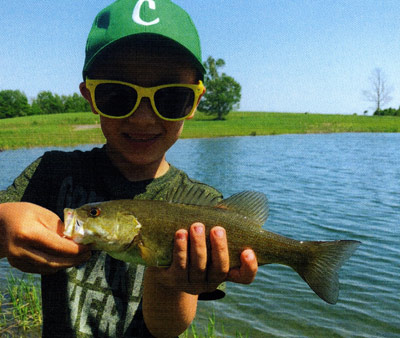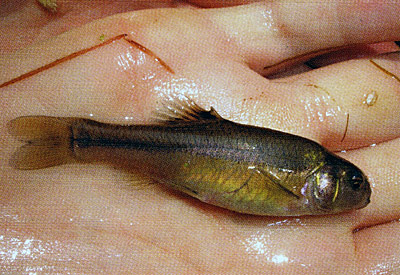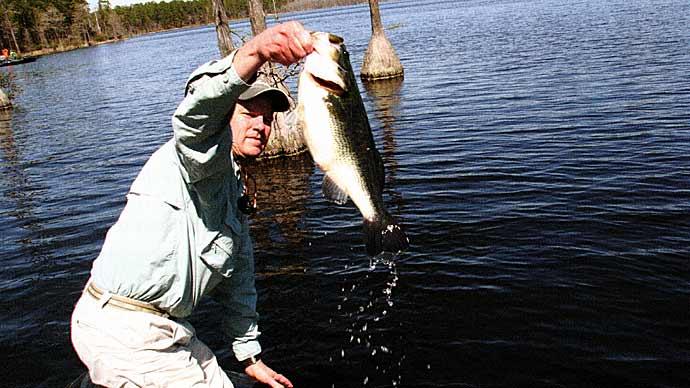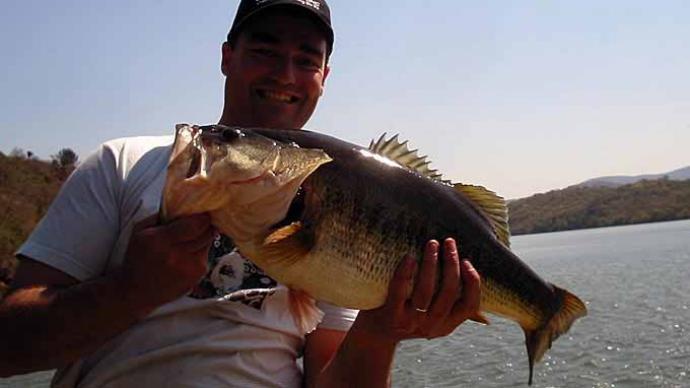
I just had some friends finish constructing a new pond. The "new pond" was constructed by demolishing an old shallow farm pond and replacing it with a much larger three-quarter acre, 10-ft. deep pond. They did everything right: planned out the new pond with an expert, hired a reputable earth mover with pond experience working in local soils, and finished off the site by grading, seeding, and mulching. The next questions that quickly followed were: "What kind of fish should we stock?" and "When can we stock them?"
Depending on goals, those questions have answers but differ for every pond and owner. The first question is, "What do you want this pond for?" They wanted deep water for swimming, views across the pond from their deck, and some nice catchable smallmouth and sunfish. Finally, they wanted a deep-water dock to jump off and have fun. Bingo, that's a place to start based on owner goals. Pond form follows function. These goals led to plans for a pond, including a steep shoreline dropping quickly into deep water. These folks did not want to swim in mats of aquatic plants. They want clean, clear water. Rooted submerged plants do not grow well in water over 6-7 feet deep because light does not penetrate at sufficient strength (due to the refraction of specific wavelengths plants need) to the bottom. Construction of a steep shoreline (2:1 slope) maximizes deep, open water and keeps pondweed growth to a minimum.
During construction, giant boulders were pushed aside, stockpiled, and added back in clusters in the corners in less than 6 feet of depth to provide a smallmouth habitat. One shoreline was left with a bench in shallower water for sunfish spawning. Other rocks were strategically placed around the pond shoreline in non-swimming areas for fish habitat.
What fish to stock?
Enter the patience.
The original goal was to have smallmouth and sunfish of a catchable size. Can a pond have those right away? Well, sure, if the fish are bought that way! But...in this case....no! Not in this pond. The pond was finished in July and will not fill until the end of September or October, depending on rainfall.
Can they stock fish now?

No, there is only about a foot of water in the pond. It takes time for the pond to fill, stabilize, and establish a food web sufficient to sustain fish. Water is the medium for the aquatic food web to grow but does not comprise the food chain itself. Just because water is immediately present does not mean it can support stocked fish. Water, nutrients, and sunlight grow plants, which are the base of the food chain. Plankton and invertebrates graze on the plants, small fish grow, and predators eat them. This web does not happen instantly. It takes time (and patience) to develop. There is nothing in the new pond yet for fish to eat immediately.
Back to fish stocking.
Fathead minnows are what I recommend as the first forage fish to stock in most new northern ponds. Stock 10 pounds of adult fathead minnows the first Fall when the pond is over half full, with at least 5 feet of water. Fatheads are tough, and the water will be cool enough for them to survive shallow water if the pond does not fill to capacity. Fatheads will survive and overwinter because they can eat detritus (dead organic material). They spawn on the undersides of flat rocks and wood in shallow water in the Spring and summer. Fatheads are very productive, and a few pounds will make hundreds of pounds in one year, depending on water fertility. But...these minnows get eaten. Quickly. The fatheads will likely be eliminated from the pond in 3 years or fewer once predators are stocked. Sad, but they were stocked to be eaten by smallmouth to jumpstart growth. A bonus with fatheads is they are aggressive predators of mosquito larvae.
In the Spring, the pond will grow planktonic algae and the food web will start percolating. In April or May stock 50-100 large golden shiners (4-6") and 50 adult pumpkinseed sunfish (4-6"). These fish will pull off a successful spawn, as will the fatheads. More patience (restraint) is called for concerning stocking predators. The goal is an entire growing season of natural forage production.
By the Fall of Year 2, there should be plenty of forage to support a few predator smallmouth bass. Add fifty 6-8" smallmouth bass in the second Fall. These bass will focus their predation primarily on the fatheads in shallow water. Meanwhile, the golden shiners will be offshore in the deeper water, eating zooplankton and insect larvae. Young of the year, pumpkinseed should be abundant in shallow water. Wispy submerged plants will start to populate the shallow waters of the pond, providing a bit of cover for the sunfish. The hope is that the fatheads will buffer the predation and allow the sunfish and golden shiners to take off.
As smallmouth bass grow, they will have mouths big enough to eat increasingly large prey. This is why I like smallmouth bass in my area of upstate New York. They do not eat all the forage in the pond. Some baitfish will be too large. The smallmouth's mouth is SMALL (compared to a largemouth). The hope is that a good number of the biggest sunfish and shiners in the pond will ALWAYS be a little too large for the biggest bass in the pond to eat. This will allow for annual crops of sunfish and shiner young of the year to provide bass with natural, self-perpetuating forage. In other words, no additional stocking is necessary once the pond food web is up and running.
I like pumpkinseed sunfish instead of bluegill in this situation because they are native and bluegill are not. Plus, pumpkinseed don't overpopulate and stunt with the smallmouth bass. The bass eat most of the young of the year sunfish, leaving a few larger fish to survive, providing fun for the kids angling for panfish. Another bonus is that pumpkinseed is one of the most strikingly beautiful sunfish you can catch. I love them.
Meanwhile, the golden shiners will mostly be in the open water at the weed edge. Shiners will be quite large in 3-4 years (6-10"). At this size, the largest smallmouth will have difficulty chasing them down and eating them due to their size and habitat preferences. Small, young-of-the-year shiners will mostly be consumed by smallmouth, which is part of the plan.
Ponds that I help manage with this fathead, pumpkinseed, golden shiner, and smallmouth arrangement will last 20+ years and produce a good number of 15-18" bass and as many 6-8" pumpkinseed as you want to catch every year. My son and his friends can head to our pond right now and have a great time catching (and releasing) really nice smallmouth and pumpkinseed.
What about largemouth and bluegill? Many pages have been written about the interactions of these two fish. I do not like either for most new ponds in northern states.
Why?
Too much management is required to produce a sustainable, quality fishery.
Bluegill are the only fish in ponds that will expand their numbers in the face of largemouth bass predation. In most ponds either the largemouth win, yielding a bass-on-bass pond with a bunch of stunted 8-10" bass and no forage. Or the bluegill win, producing a pond with one or two big bass and a zillion little 2-4" stunted bluegill that prey on bass eggs and fry, limiting bass recruitment. Keeping the balance correct for a quality fishery of both species is difficult in a small, uniform pond. Frankly, it's hard work trying to push around a fishery, often becoming more of a task than most folks want to tackle.
So, I avoid it altogether by not stocking largemouth or bluegill. Plus, I think smallmouth are more fun!
When jumpstarting a new pond, patience is the key. Let pond biology catch up to your dreams, and give the pond some time before stocking those predators!
Mark Cornwell is a professor of fisheries at the State University of New York in Cobleskill, NY. Based near the Catskill foothills, he feeds the brains of hungry fish students, offering plenty of applied science and hands-on opportunities beyond the classroom. Cornwell also works with select local landowners, collecting data and analyzing ponds, with students receiving the benefit as well. He also assists the college's aquaculture department.
Reprinted with permission from Pond Boss Magazine



